Cyclocross vs Gravel Bike — Top Differences Explained

The cyclocross vs. gravel bike debate is a new but fiery one. Cyclocross (CX) is the older, more established discipline, but it provided much of the inspiration for gravel which has since taken the world stage by storm.
Since the emergence of gravel-style riding in the US, manufacturers have poured increasing amounts of money into bicycles with characteristics to succeed on these diverse gravel courses.
Today, we have two concrete styles that share much of the same DNA but offer enough variance to fuel the conversation about which one is better and for what.
This article will compare the individual components and design characteristics of cyclocross vs. gravel bikes and where each style performs best to help you choose between them.
What Are Cyclocross and Gravel Bikes Used For?
We can sum up the difference between cyclocross vs. gravel bikes by their intended usage. Cyclocross bicycles are specialist machines for short, technical racing; gravel bicycles are the ultimate versatile bike.
Cyclocross Bikes

Trek Crockett 5 Disc cyclocross bike. | Image source: trekbikes.com
CX bikes were the original off-road drop-bar bike, optimized for races on tight and technical courses with lots of mud, grass, and sand. The specialized nature of these races means they need super responsive frames; aggressive, aero geometry, and agile handling.
The design of race-ready cross bikes must comply with UCI restrictions (cycling’s governing body). Most notable, the frames are designed to perform best with 33mm tires, a significant limiting factor for the general popularity of the category. While there may be clearance for slightly wider tires, it isn’t comparable to the massive 2.2 inches (55mm) of space seen on gravel models.
Cyclocross bikes have features that must comply with UCI regulations, which makes them slightly less versatile than gravel bikes.
Another slight disadvantage for CX bikes is the lack of diversity across models. Since the popularization of gravel bikes, manufacturers have tailored their cyclocross models for racing, so there isn’t an opportunity to pick a model suited to the riding you do, as is the case with gravel bikes.
A final consideration for cyclocross bikes is that they are faster on the road than the average gravel bike, making them a good choice for road cyclists who want a little more versatility. However, you may need to modify the drivetrain to provide enough gearing for mountain climbs and long, fast descents.
Gravel Bikes
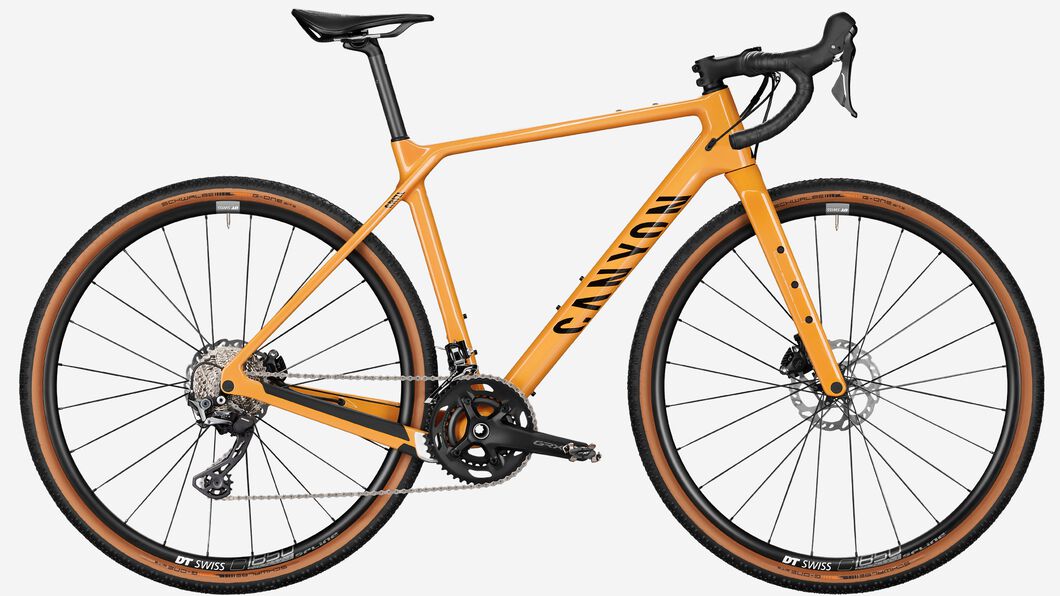
Canyon Grizl CF SL 7 gravel bike. | Image source: canyon.com
As mentioned before, gravel bikes were initially inspired by CX bikes and have continued to diverge with each passing year.
Most gravel bikes are exceptionally versatile, designed to perform at a moderate level across all terrains, except extremely technical off-road trails. These bikes are generally more fun for the average rider and more stable and safe than the race-ready CX bike.
What Is a Gravel Bike? Let us Explain
Gravel bikes excel in long-distance endurance rides, such as centuries, where you will encounter various surfaces, including pavement, gravel, forest paths, and mountain trails. The wide, grippy tires (typically 40-47mm), upright geometry, slacker angles, and copious frame mounts give gravel its versatility.
Given these characteristics, many riders use gravel for commuting, bicycle touring, and bikepacking. In addition, there is a massive variety of gravel bikes to choose from, from aero models similar to road bikes to models with fork suspension like the Cannondale Topstone Lefty.
The only downside to these bikes is they don’t excel in one specific domain (if you consider that a downside).
Cyclocross vs. Gravel Bike: Main Differences
This section will highlight the differences between a gravel bike vs. cyclocross to help you decide which bike is best for you and your riding style. As previously discussed, there is considerable variance in the designs of gravel bikes but less in cyclocross.
Geometry and Frame Design
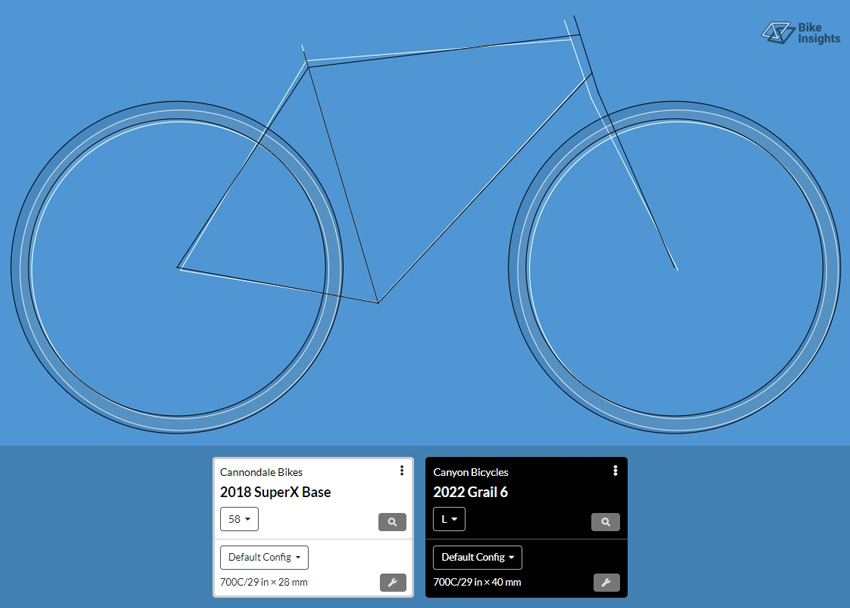
Cannondale SuperX vs Canyon Grail geometry compared. The Grail is slightly longer and taller. | Image source: bikeinsights.com
Geometry is arguably the most significant difference between gravel vs. cyclocross bikes, and although subtle, the following changes to geometry completely modify performance and ride feel.
The cyclocross bicycle is built for short, punchy racing on tight courses with a limited variety of surfaces, such as mud, grass, snow, and sand. Manufacturers, therefore, prioritize agile handling, efficient power transfer, low weight, aerodynamics, and ease of carrying.
CX bikes have higher bottom brackets (BB) with a shorter drop. BB height affects stability and control by changing the rider’s center of gravity. Gravel BB height is lower, boosting stability over more varied and extreme terrain.
How to Measure a Bike Frame — Our Easy-to-Follow Guide
Another product of a higher BB is the increased ground clearance which allows CX racers to keep pedaling over soft terrain.
Gravel bicycles have longer wheelbases and slacker headtube angles, improving control and stability but reducing agility. The CX design maintains a steep head tube angle for more agile handling, sacrificing stability. The steep head tube angle also helps keep the top tube horizontal, making it easier to shoulder the bike on carrying sections of a race.
Finally, there is far more compliance in the larger, more robust gravel tubing to enhance comfort on rougher terrain. Gravel manufacturers will use all available frame materials available to them, resulting in titanium and even steel gravel bikes.
Conversely, cyclocross manufacturers almost exclusively use carbon fiber and aluminum as they need to maximize stiffness.
Tires and Tire Clearance

Cyclocross tires (left) are much narrower and have a more aggressive tread compared to gravel tires (right).
Tires and tire clearance are the most significant differences between cyclocross bikes vs. gravel bikes, aside from geometry.
Gravel tires are all about durability and versatility. These bikes typically have a 700c x 40-47mm setup as stock, with enough comfort and traction for rough off-road terrains.
Most newer gravel bikes can support both 650b (27.5″) and 700c wheel sizes, with tire clearance up to 2.2″ on the smaller 650b wheels and frequently as high as 51mm on the 700c wheels. This range allows riders to choose tires based on personal preference, season, or even individual rides. Other common characteristics include thicker, durable materials with puncture protection.
As mentioned, cyclocross bikes have to comply with the 33mm UCI standard, meaning manufacturers optimize frame geometry around that limitation. This design leaves plenty of room for shedding mud but not much for wider tires, with max clearances no greater than 40mm.
Again, to boost performance, cyclocross tires are made with lighter, more supple materials. Unfortunately, this sacrifices durability, making them more prone to punctures.
Frame Mounts
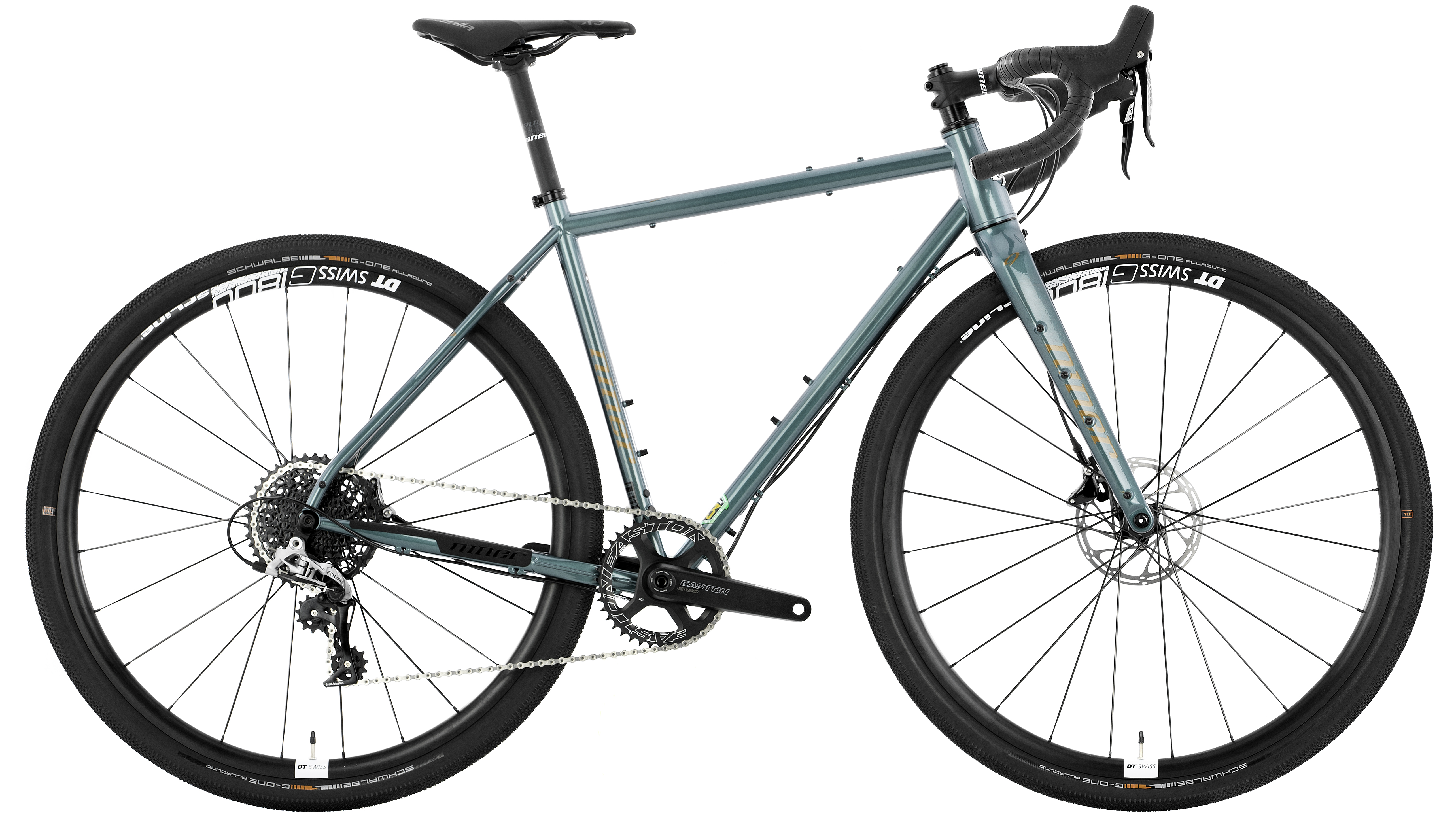
The Niner RLT steel gravel bike has a multitude of mounts to attack racks, bags, and other accessories.
Another drastic difference riders notice when comparing a gravel bike vs. a cyclocross bike is the availability of frame mounts. In general, cyclocross bikes have minimalistic frames to keep the weight low, meaning they have mounts for one or two bottle cages, and that’s it.
On the other hand, manufacturers of gravel bikes have leaned into the bicycle touring/bikepacking market, meaning your standard gravel bike has tons of mounts, including ones for three or four bottles cages, full or half frame bags, and sometimes a rack and fenders.
These options give gravel owners the ability to customize their bikes for any job or environment.
Gearing
There isn’t a giant difference in the gearing of a cyclocross bike vs. gravel bike, but there is some nuance. Cyclocross racers require smaller gear ranges as the terrain they tackle is limited to short, punchy climbs, and they typically dismount to run up the steepest gradients on the track.
For this reason, most favor a single chainring setup that helps save weight and reduce the chance of a mechanical issue.
Gravel bikes have wider gearing ranges that make them more suitable for long, sustained, steep climbs.
Gravel riders face a much wider variety of terrains and gradients, often carrying extra cargo. As such, most gravel bikes have wider gearing. Gravel drivetrains vary between single and double chainring setups, like Shimano’s GRX groupset that offers a 1x or 2x option.
Another consideration for gravel riders is how much on and off-road riding they intend to do. For example, road-heavy gravel riders may favor a double chainring to provide more options for high-speed descents on the pavement.
Handlebars
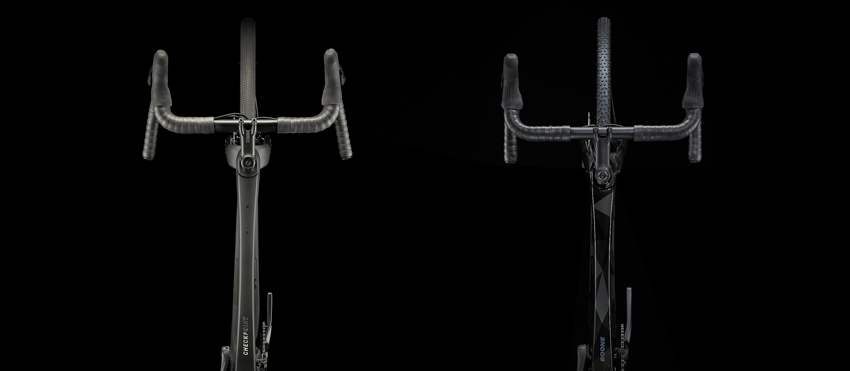
Trek Checkpoint (left) with flared drop bars compared to Trek Boone (right) with standard drop bars.
Both CX and gravel bicycles have drop handlebars. However, a couple of subtle differences in the design change how they feel.
Gravel handlebars are wider (usually 50cm wide or more) and have flared drops, which means the drop bars point slightly outwards, creating an even wider grip when you assume that position for descending.
This width boosts stability, control, and leverage for harsher terrain but makes steering more cumbersome.
Conversely, cyclocross handlebars are limited to 50cm wide by the UCI. Despite this limitation, riders use even narrower bars (based on their body size) to improve steering agility and handling in tight spaces.
Seatpost & Suspension
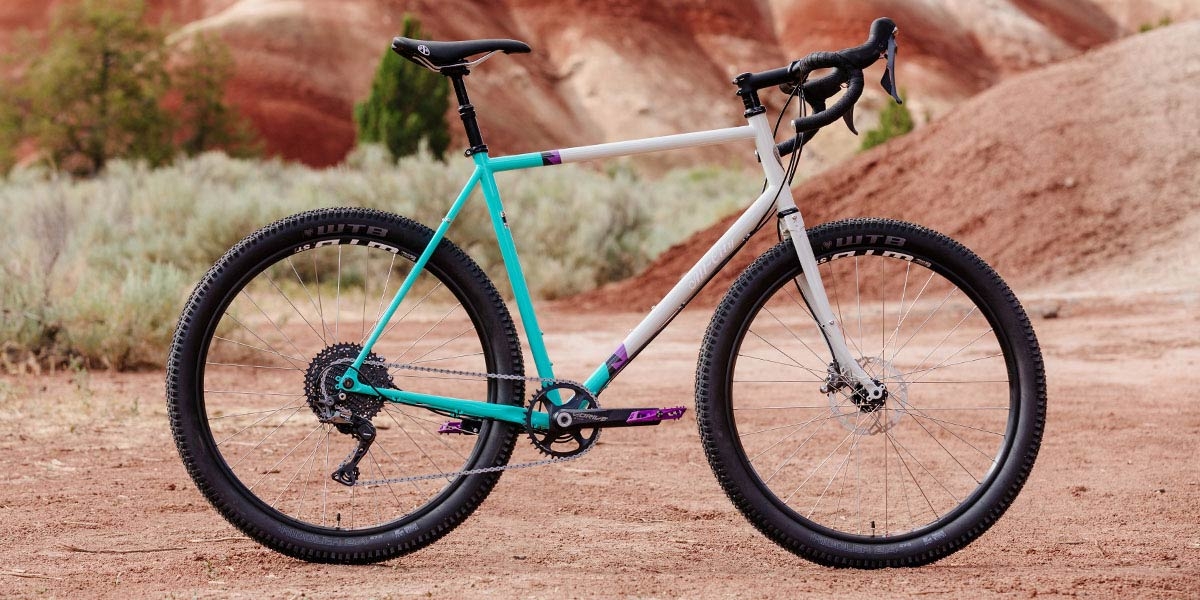
The All-City Cycles Gorilla Monsoon gravel bike comes with a dropper post that makes descents easier.
Given the greater variety available and the lack of UCI regulation, Gravel bikes feature a range of components not seen in cyclocross.
Firstly, various off-road-leaning gravel bikes are adding dropper seatposts as stock or, at minimum, the capability to switch to one. Dropper seatposts can help with technical descending by allowing the rider to get the seatpost out of the way and shift their weight back for extra stability.
Many manufacturers also add suspension to their gravel models, bridging the gap to hardtail MTBs. Gravel suspension includes frame-integrated micro-suspension, gravel-specific fork suspension, and even full suspension, as seen on Niner’s MCR 9 RDO gravel bike.
Can You Use a Cyclocross Bike as a Gravel Bike?
Cyclocross bikes perform well on most terrain except technical mountain trails, making them suitable for mixed-terrain riding, like gravel. Although they will never be quite as comfortable as gravel bikes, a CX bike will likely perform better on roads.
Ideally, you would begin by choosing a CX bike with gravel-specific attributes, such as the Cannondale CAADX. Then, to improve stability and comfort off-road, use the widest tires possible within your tire clearance, swap to flared handlebars, and, if necessary, modify your groupset so you can handle a wider variety of gradients.
Can You Use a Gravel Bike as a Cyclocross Bike?
Using your gravel bike for cyclocross racing is perfectly acceptable if you’re not competing in a UCI-level event. Gravel performs well in CX events, and many riders attempt their first race on a non-cyclocross bike.
When using your gravel bike as a cyclocross bike, the only thing you should change is the tires, which you can swap based on the event circuit. Choose deeper, more aggressive tread patterns the looser the terrain.
People Also Ask
Which is better, a cyclocross or gravel bike?
Can cyclocross go off-road?
Are cyclocross bikes good for road riding?
Is a cyclocross bike more comfortable than a road bike?
Can cyclocross bikes go on gravel?
Can you use a cyclocross bike for mountain biking?
How can I make my gravel bike faster?
Can you use a gravel bike as a mountain bike?
Is a cyclocross bike or gravel bike better for touring?
Are gravel bikes more upright?




